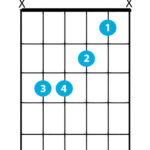Picking up an electric guitar is the first step into a world of powerful sounds and iconic music. As you get ready to play, the question often arises: “Where do I even begin?” A fundamental starting point for any electric guitarist is learning chords. But what exactly are chords, and why are they so crucial? Chords are the building blocks of harmony in music. They provide richness and depth, giving songs structure and emotional impact. Imagine music without chords – it would feel rhythmically empty and harmonically incomplete. While many instruments play chords, on electric guitar, they take on a special character, especially when amplified and distorted. Let’s dive into the world of Electric Guitar Chords for beginners, exploring different types, techniques, and songs to get you started.
The School of Rock method emphasizes practical application, encouraging students to take their lesson room skills to the stage. Whether aspiring to be a lead guitarist shredding solos or a rhythm guitarist laying down the groove, understanding chords is indispensable. Lead guitarists build melodies and solos upon chord progressions, while rhythm guitarists use chords for strumming and fingerpicking, creating the rhythmic backbone of a song. If you’re in the market for your first electric guitar or considering an upgrade, our guitar-buying guide offers valuable advice.
Understanding Basic Electric Guitar Chords
Learning chords can seem daunting at first, especially with the variety of types and ways to play them. However, for electric guitar, focusing on a few key chord types will quickly unlock a vast repertoire of songs. There are three primary types of chords that are essential for any aspiring electric guitarist.
Power Chords: The Rock Guitar Foundation
Power chords are often the first chords electric guitarists learn, and for good reason. They are the bedrock of rock, punk, metal, and countless other genres. Power chords are favored for their simplicity and impactful sound. Typically involving just two or three strings and frets, they are easier on the fingers, making them perfect for beginners. While playable on any guitar, power chords truly shine on electric guitars. When amplified, especially with distortion, they produce a thick, powerful sound that defines the electric guitar. This distorted sound can add immense character and energy to your playing, setting the mood and driving the rhythm of countless songs.
Open Chords: Versatility and Fullness on Electric Guitar
Open chords are another excellent starting point for electric guitarists. What makes them “open” is that they incorporate open strings – strings that are played without being fretted. Like power chords, open chords often utilize fewer frets and fingers compared to more complex chords, simplifying the learning process. However, unlike power chords which typically use only a few strings, open chords generally involve all six strings of the electric guitar. The common set of open chords is often referred to as “CAGED” chords, representing the shapes of C, A, G, E, and D major chords in the open position. We will explore these essential chords and how to play them shortly.
Barre Chords: Expanding Your Electric Guitar Vocabulary
Barre chords present a different challenge and tend to be more complex for beginners compared to power and open chords. However, mastering barre chords is a crucial step in your electric guitar journey. Their versatility comes from their movable nature. Once you learn a barre chord shape, you can slide it up and down the guitar neck to create a wide range of chords. This eliminates the need to memorize completely new finger positions for every chord. The challenge for beginners lies in the “barre” technique, which often requires one or sometimes two fingers to press down multiple strings at the same fret simultaneously. While they may take time to master, barre chords significantly expand your chord vocabulary and are essential for playing a vast range of electric guitar music. We’ll touch upon these further as you progress.
Getting Started with Open Electric Guitar Chords
Before diving into specific open chords, ensuring your electric guitar is properly tuned is crucial. Tuning provides the foundation for harmonious sound. If you’re new to tuning, resources like this article on tuning a guitar can provide helpful guidance to get your electric guitar sounding its best.
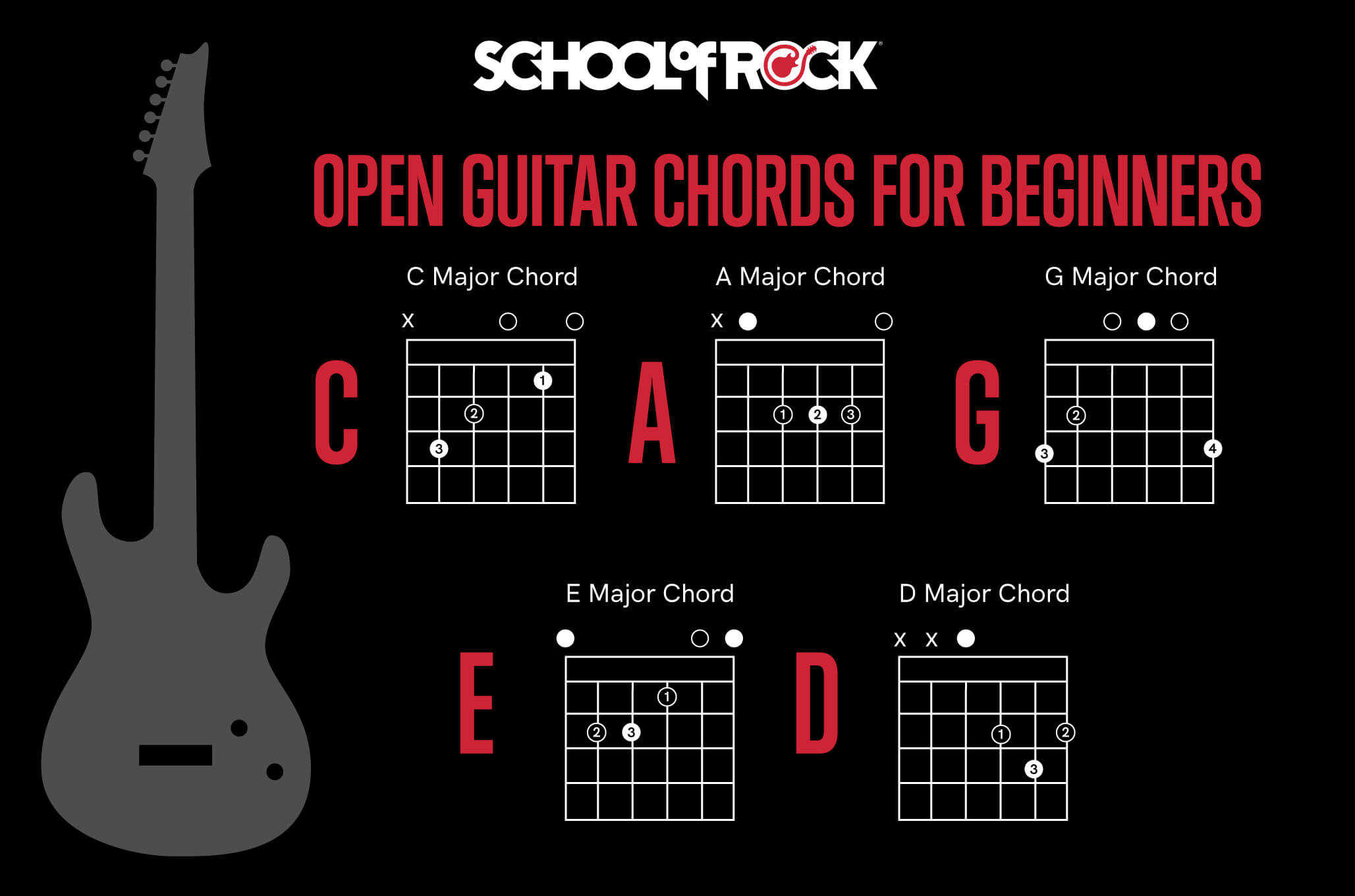 Open Guitar Chords for Beginners
Open Guitar Chords for Beginners
Let’s explore open chords, particularly the CAGED system, which is a cornerstone of the School of Rock’s performance-based method. The CAGED system is fundamental because these chords are prevalent in a vast number of popular songs that students learn and perform. Each letter in CAGED represents a major chord – C, A, G, E, and D. The diagrams below illustrate these chords, showing you exactly how to position your fingers on the fretboard.
Reading Electric Guitar Chord Diagrams
Understanding chord diagrams is essential for learning electric guitar chords. A chord diagram is a visual representation showing you which strings to play, which frets to press down, and which fingers to use. Diagrams are read horizontally. The top line represents the thickest string (low E), and the bottom line is the thinnest string (high E) – imagine holding your electric guitar upright in front of you.
- “x”: An “x” above a string indicates a muted string – it should not be played.
- “o”: A circle “o” above a string signifies an open string – play the string without pressing down any frets.
- Numbers on the frets: Numbers within the diagram indicate which finger to use on a specific fret: 1 = index finger, 2 = middle finger, 3 = ring finger, and 4 = pinky finger. The diagram itself, read from top to bottom, represents the frets, starting with the first fret at the top of the boxed area.
For example, in the A Major chord diagram: all finger placements are on the second fret. The diagram shows your index finger on the second fret of the D string, middle finger on the second fret of the G string, and ring finger on the second fret of the B string.
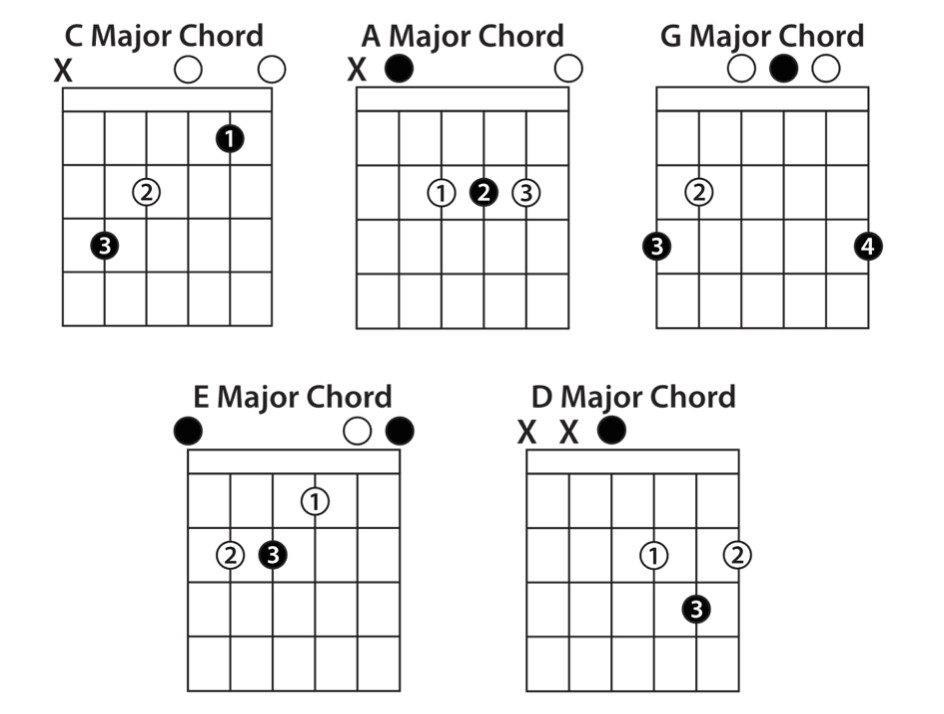 Electric Guitar CAGED Chord Diagrams
Electric Guitar CAGED Chord Diagrams
Beyond the CAGED chords, several other open chords are frequently used and are relatively easy for electric guitar beginners to learn.
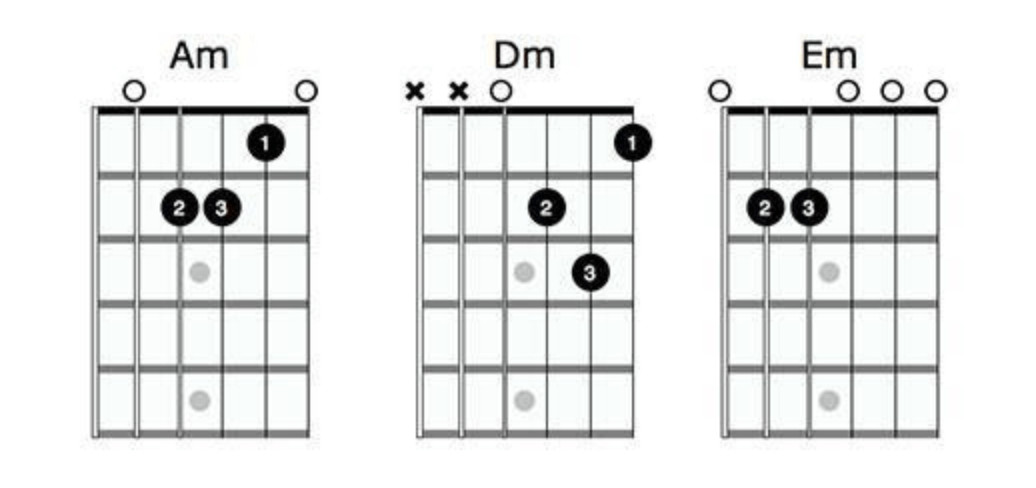 Common Beginner Electric Guitar Chords
Common Beginner Electric Guitar Chords
It’s important not to confuse chord diagrams with tablature (TAB). Tablature is another system used to read guitar music, but it represents notes and their location on the fretboard differently. In tablature, lines represent guitar strings and are read vertically. The top line is the high E string, and the bottom line is the low E string – the opposite of chord diagrams. Numbers on the TAB lines indicate the fret to be played. “0” means an open string.
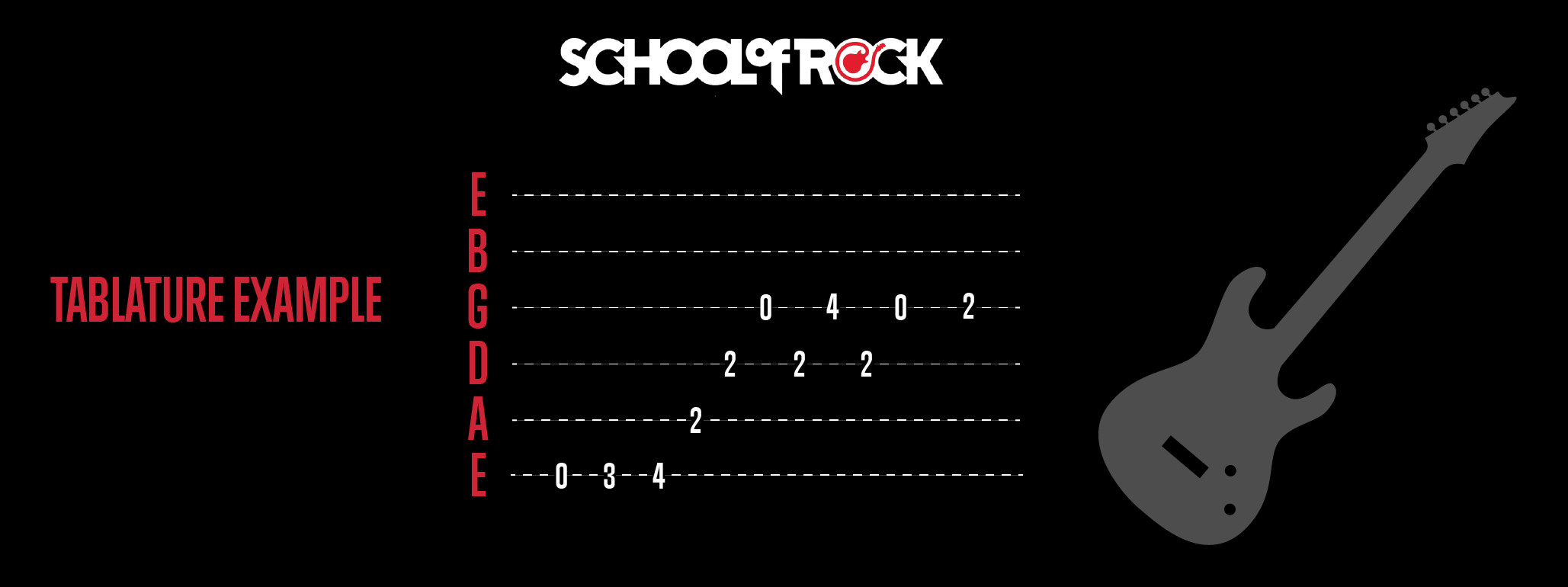 Guitar Tablature Example
Guitar Tablature Example
Chord diagrams are incredibly helpful because they not only show you the chord shape but also suggest efficient fingerings, making chord transitions smoother. With practice, these chord shapes will become ingrained in your muscle memory, and you’ll rely less on the diagrams. As you learn new electric guitar chords, keep these essential tips in mind:
- Fret Close to the Fret Wire: Position your fingers just behind the metal fret wire. This requires less pressure to produce a clear sound. Avoid fretting directly on top of or too far behind the fret wire.
- Use Your Fingertips and Arch Your Fingers: Press down on the strings with your fingertips. Arch your fingers so that only your fingertips are making contact with the strings. This prevents muting adjacent strings and ensures each note rings out clearly. Imagine your hand forming a “C” shape.
- Check Each String Individually: After forming a chord, strum each string separately to ensure every note is ringing clearly. If a string sounds muffled or buzzy, adjust your finger pressure or position until it rings true. This helps identify which finger might be causing issues.
- Practice Fretting and Unfretting: Practice transitioning into and out of chords smoothly. Remove your fingers and then quickly reform the chord shape. You can also hover your fingers just above the fretboard in the chord shape to build muscle memory and speed up chord changes.
Popular Electric Guitar Songs Using Beginner Chords
Now that you have a grasp of basic electric guitar chords, chord diagrams, and practice tips, let’s explore some songs you can start playing. Many popular songs utilize the CAGED chords and other simple chords, making them excellent practice material for beginner electric guitarists.
- “Sweet Home Alabama” by Lynyrd Skynyrd: A classic rock staple famous for its simple chord progression using C, G, and D major chords. Perfect for practicing smooth chord changes on electric guitar.
- “Bad Moon Rising” by Creedence Clearwater Revival: This catchy tune, in the key of D, uses only G, D, and A major chords. Great for developing strumming patterns and chord transitions in a rock and roll context.
- “Love Me Do” by The Beatles: In the key of G, this early Beatles hit uses G, C, and D major chords. A fantastic song for practicing fundamental open chords and basic strumming on electric guitar.
- “Eleanor Rigby” by The Beatles: Though melancholic, this song in Em (E minor) primarily uses C major and variations of Em chords. A good choice for practicing minor chords and fingerpicking patterns on electric guitar (though often played acoustically, electric versions exist and sound great).
- “Time Of Your Life” by Green Day: Originally acoustic, this song translates well to electric guitar. It’s in the key of G and uses G, C, Cadd9, and D5 power chords. For beginners, you can substitute the D5 power chord with a regular D major open chord and it will sound very similar and be easier to play initially.
- “Island in the Sun” by Weezer: This mellow rock song uses Em, Am, D, and G chords throughout. The bridge section incorporates power chords, providing an opportunity to practice both open and power chords within one song on electric guitar.
- “Boulevard of Broken Dreams” by Green Day: In Fm (F minor), this song uses Em, G, D, and A chords (relative major chords are used, making it accessible). The latter part of the song utilizes power chords, making it another excellent choice to practice transitioning between open and power chords on electric guitar.
More Electric Guitar Songs for Beginners:
- “Hey There Delilah” by Plain White T’s (Primarily acoustic, but effective on clean electric guitar)
- “Hallelujah” by Leonard Cohen (Beautiful on clean electric guitar, fingerpicking practice)
- “Redemption Song” by Bob Marley (Simple chords, great for reggae-style electric guitar strumming)
- “Smoke on the Water” by Deep Purple (Iconic riff-based, power chord practice)
- “Stairway to Heaven” by Led Zeppelin (Opening section uses fingerpicked chords, progressing to electric sections later)
- “Hotel California” by Eagles (Classic rock with recognizable chord progression, good for chord melody practice on electric guitar)
Power Chords on Electric Guitar: Simplified Power
Power chords, while simpler than open chords, share a conceptual link with barre chords. Compared to open chords, power chords use fewer notes, typically omitting the third, which makes them neither major nor minor. Let’s compare an A major chord to an A5 power chord. An A major chord contains the notes A, C#, and E. An A5 power chord contains only A and E (root and fifth). The A major chord has a major third, defining its major quality. The power chord, lacking the third, is harmonically ambiguous – it can fit in both major and minor contexts. This versatility is part of why power chords are so widely used in electric guitar music. Experiment with playing both an open chord and its power chord counterpart on your electric guitar to hear the difference in tone and harmonic color.
Compared to barre chords, power chords are generally easier to play initially. Power chords can be played in various ways. A common method is the “two-finger” power chord, using your index and ring (or pinky) finger. Three-string power chords exist as well, sometimes employing a barre-like technique where one finger presses down two strings at the same fret. Practicing barring just two strings for power chords can be a stepping stone to mastering full barre chords later on.
What musical styles are ideal for practicing power chords on electric guitar? Classic rock and much of modern pop and rock music are heavily power chord-driven. In School of Rock’s Rock 101 program, beginner electric guitarists learn power chords extensively for playing rock music. Here are some songs to practice power chords on electric guitar:
- “Wild Thing” by The Troggs: A garage rock classic that relies heavily on A5, D5, and E5 power chords, with occasional G5 power chords. Excellent for basic power chord practice and rhythm.
- “Let It Be” by The Beatles: Surprisingly adaptable to power chords! While traditionally played with open chords (C, G, Am, F), you can effectively substitute power chords like C5, G5, and F5. This showcases the versatility of power chords on electric guitar.
- “Rock and Roll” by Led Zeppelin: An iconic rock anthem built upon A5, D5, and E5 power chords. Essential for learning classic rock power chord riffs on electric guitar.
- “I Love Rock and Roll” by Joan Jett & The Blackhearts: This hard-rocking song uses E5, A5, and B5 power chords. A great track for developing energetic power chord strumming and transitions on electric guitar.
- “When I Come Around” by Green Day: The entire song is based on power chords: F#5, C#5, D#5, and B5. Excellent for practicing a sequence of power chords and developing stamina for longer power chord-based songs on electric guitar.
- “Rockin’ In the Free World” by Neil Young: Starts with E5, D5, and C5 power chords and then transitions into a mix of open and power chords (Em, D, C). A good example of how power chords and open chords can be combined in electric guitar playing.
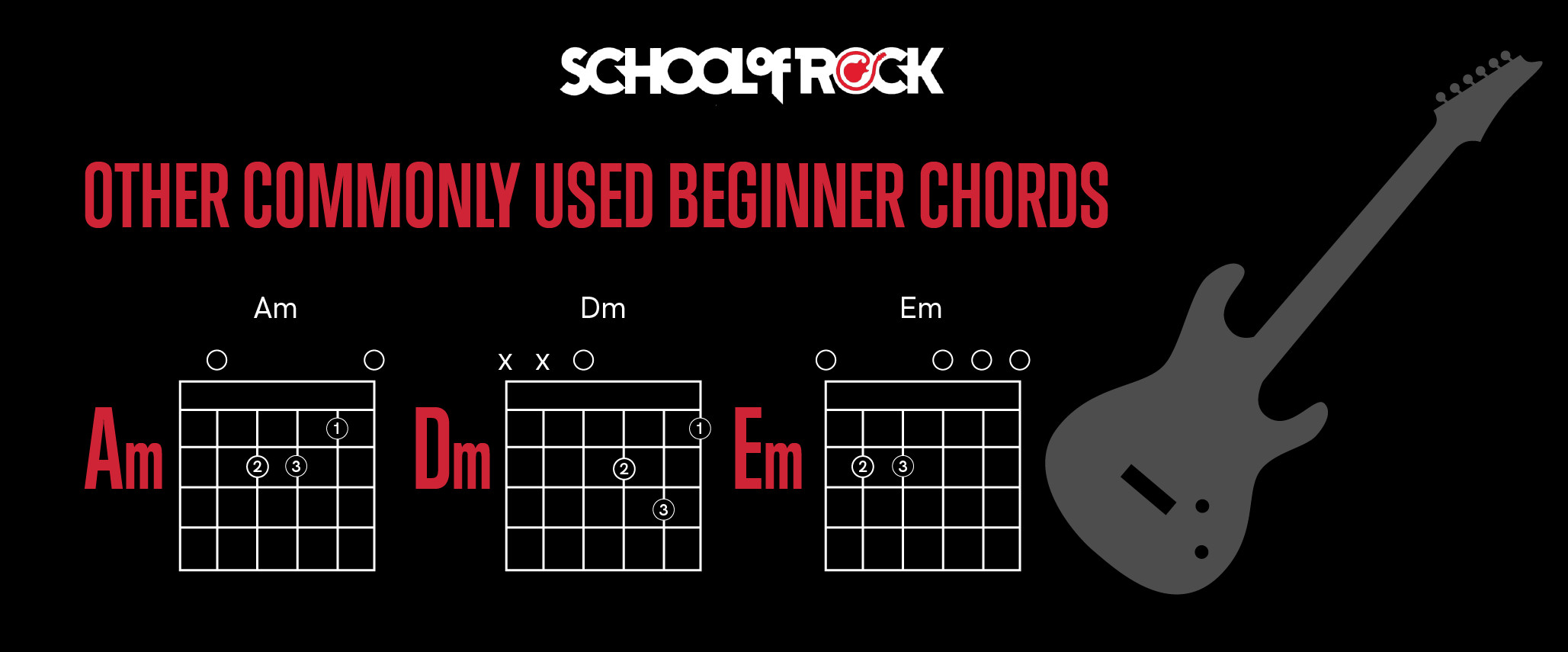 Other commonly used beginner guitar chords.
Other commonly used beginner guitar chords.
Now that you’ve explored electric guitar chords for beginners and some songs to play, are you ready to put your knowledge into practice? Do you feel you could benefit from some guidance? School of Rock is here to help! We offer private music lessons and various music programs designed to set you on the right path. Programs like Rock 101 and the Performance program are specifically designed to help beginners and intermediate players apply their private lesson learning to playing full songs in a band setting. Through these programs and lessons, students not only become skilled musicians but also develop valuable life skills through experience and teamwork. Many of the songs mentioned in this article are part of these programs, helping you master open guitar chords, power chords, and even delve into music theory. If you’re interested in learning more and taking your electric guitar playing to the next level, contact the School of Rock location nearest you!
About the Author:
Miranda Morales is a guitar and keyboard instructor at School of Rock Easton in Pennsylvania.

